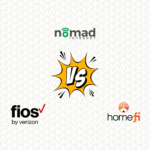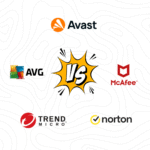Finding reliable internet in rural areas can be challenging. Many households outside cities struggle with limited wired connections, so wireless and satellite services have become popular solutions. HughesNet, Nomad, HomeFi, and Frontier DSL are four providers that focus on keeping rural communities connected. Each one uses a different approach, which gives you options depending on whether you want portability, steady home service, or traditional wired coverage. This guide looks at how these providers compare so you can choose the one that fits your needs best.
Quick Overview:
Rural homes often face fewer wired broadband choices, so having alternatives like satellite internet, portable LTE solutions, and DSL can make a real difference. These four providers give households more flexibility in staying connected, whether for work, school, or entertainment.
Key Feature Comparison:
| Feature | HughesNet | Nomad | HomeFi | Frontier DSL |
|---|---|---|---|---|
| Connection Type | Satellite | LTE & 5G | LTE & 5G | DSL over phone line |
| Top Speed | 100 Mbps | 200 Mbps | 300 Mbps | 100 Mbps |
| Data | Unlimited with Fair Access | Unlimited | Unlimited | Unlimited |
| Installation | Professional setup | Self-install | Self-install | Professional setup |
| Portability | Fixed satellite dish | Portable router | Stationary home gateway | Fixed line |
| Ideal For | Wide rural coverage | Travel and remote work | Stationary rural homes | Established households |
Performance & Reliability:
- HughesNet uses satellite technology to reach areas where no other internet option is available. It covers nearly all rural addresses in the US, offering dependable connectivity for essential browsing, work, and streaming.
- Nomad provides wireless internet through LTE and 5G networks. Its portability makes it great for RV living, travel, and homes that want the freedom to move the service easily.
- HomeFi focuses on being a stable home internet solution. It works well for families in rural or suburban locations where wired broadband is not an option.
- Frontier DSL uses existing phone lines to provide internet. While DSL is an older technology, it can still offer consistent connectivity in areas that may not yet support fiber or cable.
Plans & Pricing:
| Provider | Typical Monthly Price | Equipment | Installation |
|---|---|---|---|
| HughesNet | Around $50–$80 | Dish & modem included | Professional setup |
| Nomad | $99 | Router included | Self-install |
| HomeFi | $99 | Gateway included | Self-install |
| Frontier DSL | $40–$60 | Modem included | Professional setup |
Pros & Highlights:
| Provider | Highlights |
|---|---|
| HughesNet | Available almost everywhere, dependable for rural homes |
| Nomad | Portable and flexible, works in multiple locations |
| HomeFi | Strong choice for fixed home setups, unlimited data |
| Frontier DSL | Affordable wired option for established households |
Who Should Choose What?
- Pick HughesNet if you live in a very remote location with no access to wired or mobile coverage.
- Choose Nomad if you want a mobile internet option that works at home and on the road.
- Go with HomeFi if you want simple, unlimited wireless internet for your home.
- Select Frontier DSL if you prefer a wired solution and live in a community where DSL lines are available.
Customer Experience:
- HughesNet users value its reach in areas where no other provider is available.
- Nomad customers like its portability and flexibility for both travel and home use.
- HomeFi is appreciated for easy setup and stable home connections.
- Frontier DSL customers often like the consistency of a wired line with affordable pricing.
FAQ: Rural Internet Options:
Question 1: Is HughesNet, Nomad, HomeFi, or Frontier DSL available everywhere?
Answer: HughesNet covers nearly all rural areas with satellite service. Nomad and HomeFi depend on LTE and 5G coverage. Frontier DSL is available where phone lines are active.
Question 2: Do HughesNet, Nomad, HomeFi, or Frontier DSL include equipment?
Answer: Yes. Each provider includes the necessary hardware, such as a modem, router, or gateway, so you can get started right away.
Question 3: Which is best for traveling, HughesNet, Nomad, HomeFi, or Frontier DSL?
Answer: Nomad is designed for portability, making it the best choice for traveling households.
Question 4: Can HughesNet, Nomad, HomeFi, or Frontier DSL handle streaming?
Answer: Yes. All four providers support streaming services, with performance depending on your coverage and plan.
Question 5: Do HughesNet, Nomad, HomeFi, or Frontier DSL offer unlimited data?
Answer: Yes. All four providers include unlimited data, though HughesNet manages speeds after a certain amount of priority data.
Question 6: Which provider is best for a stationary rural home?
Answer: HomeFi and Frontier DSL are both strong fixed solutions, while HughesNet is ideal if no wired service is available.
Final Thoughts:
HughesNet, Nomad, HomeFi, and Frontier DSL each bring valuable solutions for rural homes. HughesNet ensures coverage in even the most remote locations. Nomad offers flexibility and portability. HomeFi delivers a reliable home wireless setup, and Frontier DSL provides a budget-friendly wired option.
The right choice depends on your location, your lifestyle, and whether portability, affordability, or maximum coverage matters most to you.


